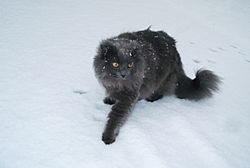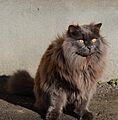Chantilly-Tiffany facts for kids
Quick facts for kids Chantilly-Tiffany |
|
|---|---|

A Chantilly-Tiffany cat in the snow
|
|
| Other names | Chantilly, Foreign Longhair |
| Origin | North America |
| Domestic cat (Felis catus) | |
The Chantilly-Tiffany is a special type of domestic cat that first appeared in North America. It is also known as the Chantilly or the Foreign Longhair. For a while, people thought this breed had disappeared completely. But luckily, it is still around and doing well!
Contents
What Does a Chantilly-Tiffany Look Like?
This cat has a body shape that is called "semi-foreign." This means it's not too chunky and not too skinny. It has a full, semi-long coat of fur. The fur feels very silky, soft, and smooth. It does not have a thick undercoat, which makes grooming easier than for some other long-haired cats.
Chantilly-Tiffany cats grow slowly. They usually reach their full size and look when they are about two years old. Their eye color also gets stronger as they get older. Their head is wide with gentle curves. They have a medium-length nose and a strong, broad, slightly square muzzle.
Colors and Patterns
The first Chantilly-Tiffany cats were chocolate brown. Now, you can find them in many colors. These include chocolate, blue, cinnamon, lilac, and fawn. They can also have different patterns. These patterns are solid, mackerel (striped), ticked (bands of color on each hair), and spotted tabby. The colors are usually very rich and deep.
An ideal Chantilly cat looks striking. This is because of its rich color and full, silky, semi-long fur. They also have a fluffy tail, a ruff (fluffy fur) around their neck, and fur inside their ears.
When they are young, their eyes are a very bright and clear yellow. As the cat gets older, this color can turn more golden.
Grooming Your Chantilly-Tiffany
Some Chantilly-Tiffany cats can groom themselves too much. This means they pull out their own hair. This can lead to bald spots and hairballs in their stomach. To help stop this, owners should brush their cat often. Brushing at least every other day helps control loose hair.
History of the Chantilly-Tiffany Cat
The Chantilly-Tiffany breed has an interesting past. It was once known as the "Foreign Longhair."
How It Started (1960s–1970s)
The breed officially began in 1967 with Jennie Robinson in New York. She bought two chocolate-colored, long-haired cats with golden eyes. Their names were "Thomas" and "Shirley." Thomas was about one year old, and Shirley was six months old.
Shirley had her first litter of six kittens in 1969. All the kittens were chocolate-colored and looked like their parents. Jennie Robinson started a breeding program to keep these traits. In the early 1970s, Thomas, Shirley, and their kittens were registered as "Foreign-Longhairs."
Passing the Breed On (1970s–1980s)
Jennie Robinson stopped her breeding program in the 1970s. Sigyn Lund, a cat breeder from Florida, bought some of Robinson's kittens. Lund continued the "Foreign Longhair" breeding program.
Judges thought the name "Foreign Longhair" was too general. They asked for a new name. Sigyn Lund changed the breed's name to "Tiffany." This name often means elegance and class. However, the cat association later stopped recognizing the "Tiffany" breed. They said it was too rare. Because of this, many of the registered cats lost their official status.
After this, some people kept advertising the breed as "Burmese." This caused a lot of confusion. Some books even said the Tiffany was a mix of Burmese and other cats. This false information almost made the breed disappear completely.
Teamwork to Save the Breed (1980s–1990s)
Around the same time, a long-haired, chocolate-colored cat appeared at a home in Canada in 1973. This cat had kittens that looked just like her. Canadian breeders rescued these kittens. They worked with Jennie Robinson and Sigyn Lund to help bring the "Tiffany" breed back in North America.
Tracy Oraas became a big supporter of the Chantilly breed in 1988. She saw an ad for "chocolate kittens." She worked with another breeder, Jan DeRegt. They tried hard to re-establish the breed. They found out that Burmese cats were never used in the Tiffany breeding program. They believed the Tiffany might have come from English breeders trying to create an Angora-type cat.
Since the original Chantillys were hard to find, breeders used other cats. These included registered European Angoras, Havana Browns, Abyssinians, and Nebelungs.
In 1992, Tracy Oraas was asked to rename the breed again. This was to avoid confusion with another cat breed called the British Tiffanie. She chose the name "Chantilly" to keep the elegant feeling of "Tiffany."
The Last Breeders (1990s–2000s)
Tracy Oraas continued to breed Chantilly-Tiffany cats until the early 2000s. After that, she stopped breeding. By 2003, Amorino Cattery in Illinois was the only known Chantilly breeder left in the U.S. The owner, Anne Davenport-Parini, worked hard to keep the breed going.
Are They Still Around?
There are stories of Chantilly-Tiffany cats still living today. One cat named Louanna was rescued in New York. It is said she now lives comfortably with her family. There are also some in Illinois. Many pictures of these cats can still be found online. This shows that they are definitely not extinct!
Images for kids
See also
 In Spanish: Chantilly-Tiffany para niños
In Spanish: Chantilly-Tiffany para niños




